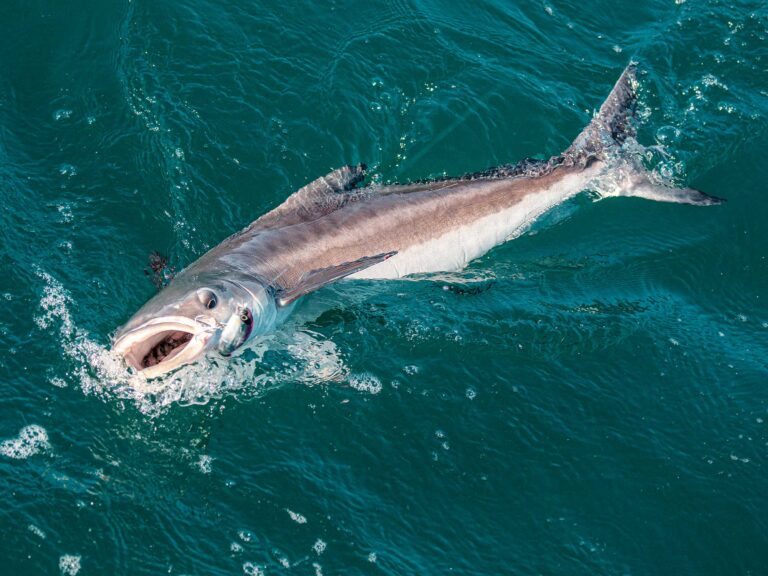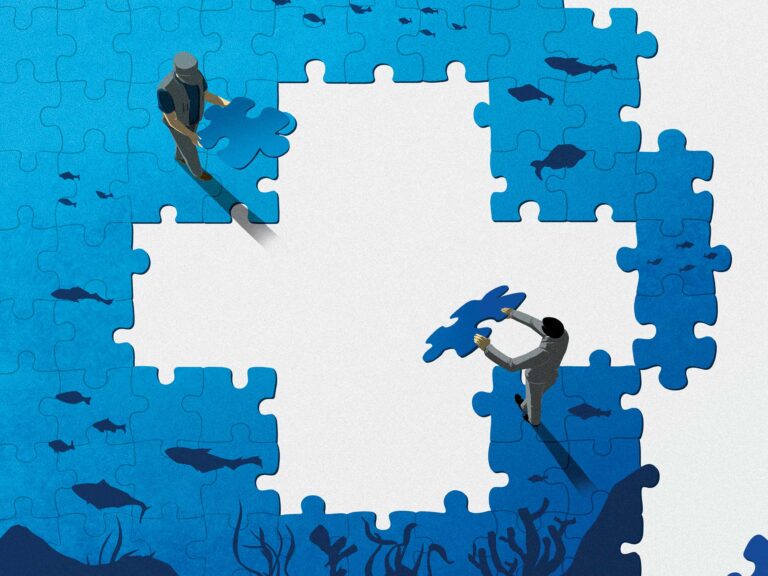
Any novice fisherman knows that the first obstacle in fishing is simply finding the fish. Experienced anglers know only too well, however, that once you spot your quarry, the hard part has only just begun. They know that whether you’re sight fishing in shallow water, casting in the suds along a beach or fishing the depths from a boat, real success will depend almost entirely on your ability to find the zone in which the fish will strike your fly. Experimenting with different flies or retrieves will do you no good if you aren’t presenting them in that zone. Being in or out of that zone can be the difference between not catching any fish or really hammering them. The following are some effective tactics to use so your fly stays in the “strike zone.”
First – Find the Strike Zone
When sight fishing in skinny water for species such as bones, reds, snook, tarpon or even stripers, the strike zone will usually depend almost entirely upon water visibility and the fish’s ability to see, or hear, the fly. In clear water, the strike zone may be several feet extending from the sides and to the front of the fish. In turbid water, the strike zone may be reduced to less than 1 foot, or even mere inches. To complicate matters even more, most of the time these prized shallow-water species are almost always on the move searching for prey. In other situations, a bonefish or redfish may be tilted down rooting around on the bottom and will not see your fly unless you plop it down right on its head. Accurate casting becomes a must in these situations.
Most of the time when fishing in open water for species such as striped bass or bluefish, they are hidden from view and feeding below the surface. A depth finder often will be your best tool to quickly determine the depth and extent of the fish in the area. The depth of the fish will dictate the most appropriate weight of line to use – a floating line for surface-feeding fish, an intermediate for just below the surface or any of a variety of weighted lines to reach the desired depth down to 20 feet or more. If you don’t have a depth finder, you’ll have to resort to experimentation by casting a weighted line with a known sink rate (i.e., 450-grains that sinks approximately 8 inches per second) and counting down and retrieving at different depths until you get a strike. If you have a fishing buddy or two on board, you can use different weighted lines and retrieve at different depths to see which works best. Once you get a strike you’ll know the approximate depth and can then change lines as needed to get quickly back down to the strike zone.
As an example, Rick Bender and I were fishing the upper Chesapeake in the spring. Stripers were showing up on the depth finder from 10 to 20 feet down with the highest concentration being between 18 and 20 feet deep. I was using a 550-grain weighted line and was hooking up every now and then. Bender, on the other hand, was better prepared with his 850-grain shooting-head system and was hooking up with much greater consistency. He was not only able to get his fly down to the primary strike zone quicker, but his fly stayed in that deeper zone longer. The result: Bender caught more and bigger fish, including a nice 20-pounder.
Keep Your Fly in the Water
It’s a basic law of fly fishing; your fly needs to be in the water to catch fish. While virtually everyone agrees, many anglers do not practice this law to its fullest potential. Call me crazy, but I like to catch fish. Fishing is OK, but for me catching is where it’s at. So when I’m fishing, I try to maximize the time my fly stays in the water, and over the years I’ve tried to develop good habits that will increase my odds of success.
Some of these habits sound overly obvious, but sometimes it’s the obvious oversights that set us back. A few helpful hints:
Hint 1 Have your rods and reels checked, rigged and ready to go the night before. Spending time rigging and unrigging on location means you’re not fishing.
**
Hint 2** Bring multiple rods, reels and spools (if possible) that are set up for a variety of fishing situations that may be encountered during the day. If you have three rods, set one up with an intermediate, another with a medium-sinking line and another with a fast-sinking line. You may also want to have some rods set up with different flies. You can switch rods almost without losing a heartbeat … let alone a fish.
Hint 3 Minimize your false casting. This is critical when sight fishing for bones, tarpon and even stripers and albacore when there is only a very narrow window of opportunity. If your fly is in the air, it’s not going to catch a fish. False casting also steals valuable time from fishing. As an example, a typical eight-hour day of striper fishing from a boat may include 500 blind casts. If you were to make two extra false casts for every cast, that would equate to an extra 1,000 false casts per day. If each false cast took two seconds that would mean you lost a total of approximately 33 minutes of your fly not being in the water.
** Hint 4** Only put a fish on the reel if they earn it. Albies, bones … no problem, but if you’re catching weakfish, small blues and especially schoolie-size stripers, they rarely take any line. Just strip them in by hand. When the fishing gets hot, it usually doesn’t last forever, so you want to take advantage of every second. If you put every fish on the reel, you’ll have to take time to strip all that line back out off the reel and false cast a bunch of times to finally get the fly back in the water. On the other hand, if you strip the fish in and release it, you can begin casting immediately and get the fly back in the water much quicker.
** Hint 5** Match the equipment to the size of the fish and fight them correctly to avoid prolonging the fight. The issue here is to balance the desire for a fair fight with the responsibility of landing the fish in a reasonable amount of time for a healthy release, and for another cast.
Make Your Casts Long and Accurate
Yes, you can catch fish without casting great distances, but I’ll guarantee that you’ll catch far more in most situations if you can cast longer and with more accuracy. This is certainly true in skinny-water situations with spooky fish or when fish are busting just off the beach; in either case, the only way to reach the fish is with a long, accurate cast. But longer and more accurate casts are also critical in many other situations. The sudden swirl or boil of a surface-feeding striper may appear without warning. Your ability to deliver your fly to that small fleeting strike zone could be the difference between the catch of the day and the one that got away.
Also, when blind-casting from a boat or the beach, a longer cast potentially puts the fly in front of more fish and keeps it in the strike zone longer. Being capable of casting 70 feet vs. 50 feet will definitely translate to catching more fish during the course of the day or season.
Shorten and Slow Down the Retrieve
I don’t know about you, but when I cast into breaking stripers, blues or albies, my heart starts racing and I have a tendency to start ripping the fly through the water. This may work with very high concentrations of breaking fish, but some very frustrating experiences have taught me to shorten and slow down the retrieve for more consistent hookups.
During my early experiences with albacore in the Cape Lookout area of North Carolina, fish were chasing bait at the surface in small groups of three to four fish. I could get the cast quickly to the boils, but would strip the fly like a madman right out of the strike zone in all the excitement. I’d come up empty each time. Once I realized what was happening, I would make the cast to the boils, resist the urge and let it sit for a second or two. If I didn’t get a strike, I would usually just have to twitch it a few inches to entice a take. What a huge difference.
Shorter, slower retrieves also work especially well for stripers when they are feeding below the surface. If you’re marking lots of fish on the depth sounder and you feel the fly is right in their midst, don’t be too anxious. Bigger stripers usually hang under the smaller, more active fish just waiting for some tasty morsels to slowly drift down. Slow down your retrieve and you might just be in for a surprise.
Don’t Yank the Fly Away
Flats fishermen face an early choice: Either learn to not yank the fly away, or go insane from missed opportunities. How many times have you experienced this yourself? There you are on the flats with a beautiful 10-pound bone or 20-pound striper in plain view just 50 feet away. You make a great presentation; the fly gently touches down a foot or two in front of the fish. He sips the fly in and you feel some slight resistance. With your heart pounding, you give a long strip-strike and raise your rod with great anticipation of coming tight against the weight of that magnificent fish. To your utter dismay, you feel nothing as your watch your fly leap from the fish’s mouth and land some 10 feet away. The fish can’t find the fly that escaped its grasp and swims away.
While the flats fisherman often sees the entire scenario unfold before his eyes, similar bungles happen to those of us fishing in deeper and/or more turbid water. The problem in both cases is more than missing the hookup; the combination of a hard strip-strike and a lifted rod tip results in a fly that’s pulled far out of the strike zone, eliminating any chance of a second take. Such hard tugs also eliminate the chance to pick up fellow schoolmates that might be nearby, especially when fishing for stripers or blues.
To prevent missing these opportunities, try keeping your strip-strikes short and not too hard, and keep the rod pointed at the fish. Once you feel the weight of the fish, you may want to give a few short rapid strikes to set the hook firmly, and then raise the rod.
Use Anchors
I spend most of my time fishing from a boat searching for schooling fish or working structure like bridges, rock piles, ledges, etc. Normally I don’t like using an anchor, simply because eventually I’ll have to go to the trouble of pulling it in, and because drifting is usually productive for me. However, if fish are holding over specific parts of a structure and you’re only getting one or two hits before having to reposition for another drift, using an anchor may be the ticket to stay in the strike zone.
The use of a sea anchor can also be a very effective way to keep your boat in the strike zone longer. The sea anchor – essentially a large flexible funnel with a line tied off to the boat – causes drag and slows down the boat’s drift in fast current or on windy days, enabling you to stay over fish longer. They also have another benefit. By reducing your drift speed, sinking lines are more likely to stay down where the fish are feeding.









